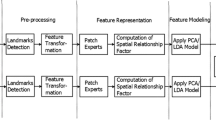Abstract
This paper describes the challenges that involve developing a software capable of capturing users’ faces on mobile devices in a non-collaborative environment. The goal is to generate a set of quality training samples of the user’s face for the construction of a model that can be used in a later phase of biometric identification. To this end, a supervised learning system is integrated to determine when a photo should be taken. This learning is supported by a varied input data set that contains information regarding the pose of the device, its manipulation and other environmental factors such as lighting. The software also has different ways of working with the objective of not wasting resources and be little invasive. Working modes are managed with an easy-to-maintain and scalable rules-based system. The experimental results show the robustness of the proposal.
Access this chapter
Tax calculation will be finalised at checkout
Purchases are for personal use only
Similar content being viewed by others
Notes
- 1.
A Service is an Android component representing either an application’s task to perform a longer-running operation while not interacting directly with the user or to supply functionality for other applications to use.
- 2.
This data set was obtained by performing a training in a mobile phone.
References
Vincent, J., Taipale, S., Sapio, B., Lugano, G., Fortunati, L.: Social robots from a human perspective (2015)
Vincent, J.: Is the mobile phone a personalized social robot. Intervalla 1(1), 60–70 (2013)
Vincent, J.: The mobile phone: An emotionalised social robot. In: Social robots from a human perspective, pp. 105–115 (2015)
Klare, B.F., et al.: Pushing the frontiers of unconstrained face detection and recognition: IARPA Janus Benchmark A. In: Proceedings of the 2015 IEEE Conference on Computer Vision and Pattern Recognition, pp. 1931–1939 (2015)
Huang, G.B., Ramesh, M., Berg, T., Learned-Miller, E.: Labeled faces in the wild: A database for studying face recognition in unconstrained environments. Technical Report UM-CS-2007-049. University of Massachusetts, Amherst (2007)
Jain, V., Learned-Miller, E.: FDDB: A Benchmark for Face Detection in Unconstrained Settings. Technical Report UM-CS-2010-009. University of Massachusetts, Amherst (2010)
Wolf, L., Hassner, T., Maoz, I.: Face recognition in unconstrained videos with matched background similarity. In: Proceedings of the 2011 IEEE Conference on Computer Vision and Pattern Recognition, pp. 529–534 (2011)
McCool, C., et al.: Bi-modal person recognition on a mobile phone: using mobile phone data. In: Proceedings of the 2012 IEEE International Conference on Multimedia and Expo Workshops (ICMEW), pp. 635–640 (2012)
Beveridge, J.R., et al.: The challenge of face recognition from digital point-and-shoot cameras. In: 2013 IEEE Sixth International Conference on Biometrics: Theory, Applications and Systems (BTAS), pp. 1–8. IEEE (2013)
Madgwick, S.O.: An efficient orientation filter for inertial and inertial/magnetic sensor arrays. Technical Report, University of Bristol (UK), vol. 25 (2010)
Madgwick, S.O., Harrison, A.J., Vaidyanathan, R.: Estimation of IMU and MARG orientation using a gradient descent algorithm. In: Proceedings of the IEEE International Conference on Rehabilitation Robotics (ICORR 2011), pp. 1–7. IEEE (2011)
Viola, P., Jones, M.J.: Robust real-time face detection. Int. J. Comput. Vis. 57(2), 137–154 (2004)
OpenCV 3.0.0-rc1 Documentation: Introduction, June 2017. http://docs.opencv.org/3.0-rc1/d1/dfb/intro.html
Acknowledgment
This work has received financial support from the Consellería de Cultura, Educación e Ordenación Universitaria (accreditations 2016–2019, EDG431G/01 and ED431G/08, and reference competitive group 2014–2017, GRC2014/030), the European Regional Development Fund (ERDF) and FEDER funds of the EU.
Author information
Authors and Affiliations
Corresponding author
Editor information
Editors and Affiliations
Rights and permissions
Copyright information
© 2018 Springer International Publishing AG
About this paper
Cite this paper
Casado, F.E., Regueiro, C.V., Iglesias, R., Pardo, X.M., López, E. (2018). Automatic Selection of User Samples for a Non-collaborative Face Verification System. In: Ollero, A., Sanfeliu, A., Montano, L., Lau, N., Cardeira, C. (eds) ROBOT 2017: Third Iberian Robotics Conference. ROBOT 2017. Advances in Intelligent Systems and Computing, vol 693. Springer, Cham. https://doi.org/10.1007/978-3-319-70833-1_45
Download citation
DOI: https://doi.org/10.1007/978-3-319-70833-1_45
Published:
Publisher Name: Springer, Cham
Print ISBN: 978-3-319-70832-4
Online ISBN: 978-3-319-70833-1
eBook Packages: EngineeringEngineering (R0)




